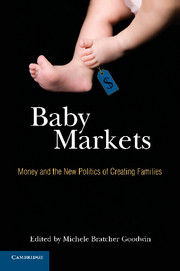Book contents
- Frontmatter
- Contents
- Preface
- Acknowledgments
- Introduction
- PART ONE WHAT MAKES A MARKET? EFFICIENCY, ACCOUNTABILITY, AND RELIABILITY OR GETTING THE BABIES WE WANT
- PART TWO SPACE AND PLACE: REPRODUCING AND REFRAMING SOCIAL NORMS OF RACE, CLASS, GENDER, AND OTHERNESS
- PART THREE SPECTRUMS AND DISCOURSES: RIGHTS, REGULATIONS, AND CHOICE
- 10 Reproducing Dreams
- 11 Why Do Parents Have Rights?: The Problem of Kinship in Liberal Thought
- 12 Free Markets, Free Choice?: A Market Approach to Reproductive Rights
- 13 Commerce and Regulation in the Assisted Reproduction Industry
- 14 Ethics within Markets or a Market for Ethics?: Can Disclosure of Sperm Donor Identity Be Effectively Mandated?
- PART FOUR THE ETHICS OF BABY AND EMBRYO MARKETS
- PART FIVE TENUOUS GROUNDS AND BABY TABOOS
- Author Bios
- Index
- References
10 - Reproducing Dreams
Published online by Cambridge University Press: 05 August 2012
- Frontmatter
- Contents
- Preface
- Acknowledgments
- Introduction
- PART ONE WHAT MAKES A MARKET? EFFICIENCY, ACCOUNTABILITY, AND RELIABILITY OR GETTING THE BABIES WE WANT
- PART TWO SPACE AND PLACE: REPRODUCING AND REFRAMING SOCIAL NORMS OF RACE, CLASS, GENDER, AND OTHERNESS
- PART THREE SPECTRUMS AND DISCOURSES: RIGHTS, REGULATIONS, AND CHOICE
- 10 Reproducing Dreams
- 11 Why Do Parents Have Rights?: The Problem of Kinship in Liberal Thought
- 12 Free Markets, Free Choice?: A Market Approach to Reproductive Rights
- 13 Commerce and Regulation in the Assisted Reproduction Industry
- 14 Ethics within Markets or a Market for Ethics?: Can Disclosure of Sperm Donor Identity Be Effectively Mandated?
- PART FOUR THE ETHICS OF BABY AND EMBRYO MARKETS
- PART FIVE TENUOUS GROUNDS AND BABY TABOOS
- Author Bios
- Index
- References
Summary
Eggs, sperm, and embryos are sold – and they are often sold to the highest bidder. The price of a desirable egg may be more than fifty thousand dollars, although eggs are available for less. X and Y Consulting, which claims to be the “longest operating donor recruiting agency in the U.S.,” explains that its donor fee is based on the cost of living and wage rates in the state where the donor lives, so the fee can be quite variable; and in addition to the actual cost of the egg, the consumer will also pay various expenses associated with the donation process, including medical fees as well as transportation. Egg producers can earn sizeable fees. The George Washington University Medical Center pays egg donors a standard four thousand dollars and earnestly explains that the money is earned income, and so it must be reported on the recipient's tax return. The Ethics Committee of the American Society for Reproductive Medicine has even defended payment for eggs, explaining that payment does not discourage the provider's altruistic motivations and also promotes fairness to the providers.
Sperm sales are a transnational market. The price of a sperm vial ranges, but it may cost hundreds of dollars. In 2006, the cheapest vial of sperm available from the Sperm Bank of California, a nonprofit organization, cost 295 dollars, while shipping charges added at least another 190 dollars.
- Type
- Chapter
- Information
- Baby MarketsMoney and the New Politics of Creating Families, pp. 147 - 163Publisher: Cambridge University PressPrint publication year: 2010

